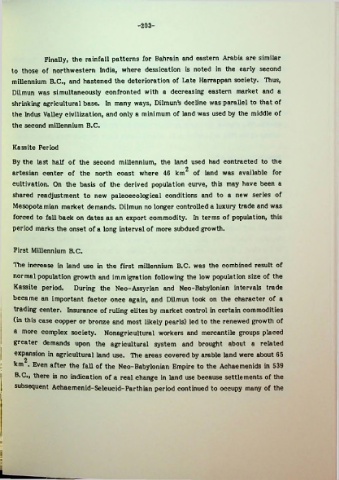Page 227 - Life & Land Use on the Bahrain Islands (Curtis E Larsen)
P. 227
-203-
Finally, the rainfall patterns for Bahrain and eastern Arabia are similar
to those of northwestern India, where dessication is noted in the early second
millennium B.C., and hastened the deterioration of Late Harrappan society. Thus,
Dilmun was simultaneously confronted with a decreasing eastern market and a
shrinking agricultural base. In many ways, Dilmun^s decline was parallel to that of
the Indus Valley civilization, and only a minimum of land was used by the middle of
the second millennium B.C.
Kassite Period
By the last half of the second millennium, the land used had contracted to the
artesian center of the north coast where 46 km of land was available for
cultivation. On the basis of the derived population curve, this may have been a
shared readjustment to new paleoecological conditions and to a new series of
Mesopotamian market demands. Dilmun no longer controlled a luxury trade and was
forced to fall back on dates as an export commodity. In terms of population, this
period marks the onset of a long interval of more subdued growth.
First Millennium B.C.
Tlie increase in land use in the first millennium B.C. was the combined result of
normal population growth and immigration following the low population size of the
Kassite period. During the Neo-Assyrian and Neo-Babylonian intervals trade
became an important factor once again, and Dilmun took on the character of a
trading center. Insurance of ruling elites by market control in certain commodities
(in this case copper or bronze and most likely pearls) led to the renewed growth of
a more complex society. Nonagricultural workers and mercantile groups placed
greater demands upon the agricultural system and brought about a related
expansion in agricultural land use. The areas covered by arable land were about 65
km . Even after the fall of the Neo-Babylonian Empire to the Achaemenids in 539
B.C., there is no indication of a real change in land use because settlements of the
subsequent Achaemenid-Seleucid-Parthian period continued to occupy many of the
5

